
Concept explainers
(a)
Interpretation:
The product for the reaction of ethylbenzene with bromine gas and
Concept introduction:
An electrophilic
Answer to Problem 16.35AP
No product will be formed in the reaction of ethylbenzene with bromine gas and
Explanation of Solution
Ethylbenzene is ortho and para directing group, the electrophile will substitute on either ortho or para position of the benzene ring. In the dark no bromine free radical will be generated, therefore, no free radical reaction will occur. Carbon tetrachloride does not facilitate the production of positively charged
No reaction takes place between ethylbenzene with bromine gas and
(b)
Interpretation:
The product for the reaction ethylbenzene with
Concept introduction:
An electrophilic aromatic substitution reaction is a type of reaction in which an electrophile substitutes a hydrogen atom of the aromatic ring. Aromatic ring does not easily undergo nucleophilic substitution reaction; however, it undergoes electrophilic substitution reaction easily.
Answer to Problem 16.35AP
The products for the reaction ethylbenzene with
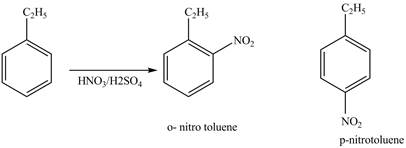
Explanation of Solution
Ethylbenzene is ortho and para directing group, the electrophile will substitute on either ortho or para position of the benzene ring. The nitronium ion
The corresponding
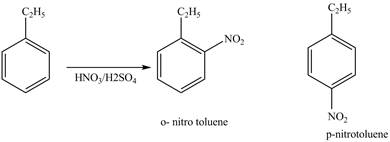
Figure 1
The products for the reaction ethylbenzene with
(c)
Interpretation:
The product for the reaction ethylbenzene with concentrated
Concept introduction:
An electrophilic aromatic substitution reaction is a type of reaction in which an electrophile substitutes a hydrogen atom of the aromatic ring. Aromatic ring does not easily undergo nucleophilic substitution reaction; however, it undergoes electrophilic substitution reaction easily.
Answer to Problem 16.35AP
The products for the reaction ethylbenzene with concentrated

Explanation of Solution
Ethylbenzene is ortho and para directing group, the electrophile will substitute on either ortho or para position of the benzene ring. In the presence of concentrated sulphuric acid, the

Figure 2
The products for the reaction ethylbenzene with concentrated
(d)
Interpretation:
The product for the reaction ethylbenzene with propionyl chloride and
Concept introduction:
Friedel Craft acylation is an electrophilic aromatic substitution reaction. In this reaction, the synthesis of the monoacylated product takes place from the reaction between aromatic rings and acyl chlorides.
Answer to Problem 16.35AP
The products for the reaction of ethylbenzene with propionyl chloride and

Explanation of Solution
Friedel-Crafts alkylation permits the synthesis of alkylated products by the reaction of arenes with alkyl chlorides in the presence of aluminum chloride (Lewis acid). This alkylation reaction comes under the category of electrophilic aromatic substitution. Ethylbenzene is ortho and para directing group, the electrophile will substitute on either ortho or para position of the benzene ring. The acyl group attacks either ortho or para position of ethylbenzene to form the product. The corresponding chemical reaction is shown below.

Figure 3
The products for the reaction ethylbenzene with propionyl chloride and
(e)
Interpretation:
The product for the exothermic reaction of ethylbenzene with
Concept introduction:
An electrophilic aromatic substitution reaction is a type of reaction in which an electrophile substitutes a hydrogen atom of the aromatic ring. Aromatic ring does not easily undergo nucleophilic substitution reaction; however, it undergoes electrophilic substitution reaction easily.
Answer to Problem 16.35AP
The product for the exothermic reaction of ethylbenzene with
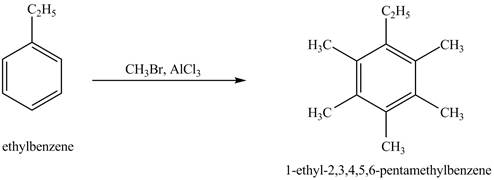
Explanation of Solution
Ethylbenzene is ortho and para directing group, the electrophile will substitute on either ortho or para position of the benzene ring. In the presence of
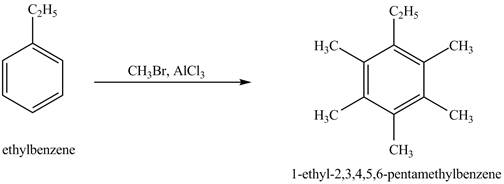
Figure 4
The product for the exothermic reaction of ethylbenzene with
(f)
Interpretation:
The product for the exothermic reaction of ethylbenzene with bromine gas and
Concept introduction:
An electrophilic aromatic substitution reaction is a type of reaction in which an electrophile substitutes a hydrogen atom of the aromatic ring. Aromatic ring does not easily undergo nucleophilic substitution reaction; however, it undergoes electrophilic substitution reaction easily.
Answer to Problem 16.35AP
The products for the exothermic reaction of ethylbenzene with bromine gas and
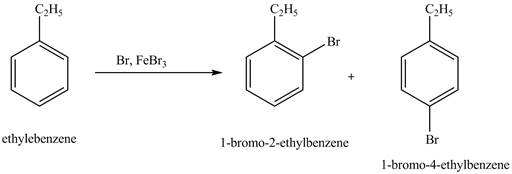
Explanation of Solution
Ethylbenzene is ortho and para directing group, the electrophile will substitute on either ortho or para position of the benzene ring. In this reaction, positively charged
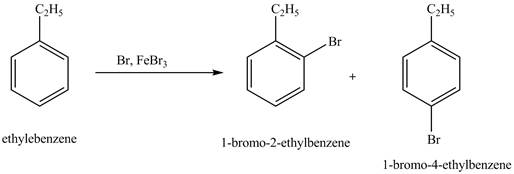
Figure 5
The products for the exothermic reaction ethylbenzene with bromine gas and
Want to see more full solutions like this?
Chapter 16 Solutions
ORGANIC CHEMISTRY SAPLING ACCESS + ETEX
- What is the stepwise mechanism for this reaction?arrow_forward32. Consider a two-state system in which the low energy level is 300 J mol 1 and the higher energy level is 800 J mol 1, and the temperature is 300 K. Find the population of each level. Hint: Pay attention to your units. A. What is the partition function for this system? B. What are the populations of each level? Now instead, consider a system with energy levels of 0 J mol C. Now what is the partition function? D. And what are the populations of the two levels? E. Finally, repeat the second calculation at 500 K. and 500 J mol 1 at 300 K. F. What do you notice about the populations as you increase the temperature? At what temperature would you expect the states to have equal populations?arrow_forward30. We will derive the forms of the molecular partition functions for atoms and molecules shortly in class, but the partition function that describes the translational and rotational motion of a homonuclear diatomic molecule is given by Itrans (V,T) = = 2πmkBT h² V grot (T) 4π²IKBT h² Where h is Planck's constant and I is molecular moment of inertia. The overall partition function is qmolec Qtrans qrot. Find the energy, enthalpy, entropy, and Helmholtz free energy for the translational and rotational modes of 1 mole of oxygen molecules and 1 mole of iodine molecules at 50 K and at 300 K and with a volume of 1 m³. Here is some useful data: Moment of inertia: I2 I 7.46 x 10- 45 kg m² 2 O2 I 1.91 x 101 -46 kg m²arrow_forward
- K for each reaction step. Be sure to account for all bond-breaking and bond-making steps. HI HaC Drawing Arrows! H3C OCH3 H 4 59°F Mostly sunny H CH3 HO O CH3 'C' CH3 Select to Add Arrows CH3 1 L H&C. OCH3 H H H H Select to Add Arrows Q Search Problem 30 of 20 H. H3C + :0: H CH3 CH3 20 H2C Undo Reset Done DELLarrow_forwardDraw the principal organic product of the following reaction.arrow_forwardCurved arrows are used to illustrate the flow of electrons. Using the provided structures, draw the curved arrows that epict the mechanistic steps for the proton transfer between a hydronium ion and a pi bond. Draw any missing organic structures in the empty boxes. Be sure to account for all lone-pairs and charges as well as bond-breaking and bond-making steps. 2 56°F Mostly cloudy F1 Drawing Arrows > Q Search F2 F3 F4 ▷11 H. H : CI: H + Undo Reset Done DELLarrow_forward
- Calculate the chemical shifts in 13C and 1H NMR for 4-chloropropiophenone ? Write structure and label hydrogens and carbons. Draw out the benzene ring structure when doing itarrow_forward1) Calculate the longest and shortest wavelengths in the Lyman and Paschen series. 2) Calculate the ionization energy of He* and L2+ ions in their ground states. 3) Calculate the kinetic energy of the electron emitted upon irradiation of a H-atom in ground state by a 50-nm radiation.arrow_forwardCalculate the ionization energy of He+ and Li²+ ions in their ground states. Thannnxxxxx sirrr Ahehehehehejh27278283-4;*; shebehebbw $+$;$-;$-28283773838 hahhehdvaarrow_forward
- Plleeaasseee solllveeee question 3 andd thankss sirr, don't solve it by AI plleeaasseee don't use AIarrow_forwardCalculate the chemical shifts in 13C and 1H NMR for 4-chloropropiophenone ? Write structure and label hydrogens and carbonsarrow_forwardPlease sirrr soollveee these parts pleaseeee and thank youuuuuarrow_forward
